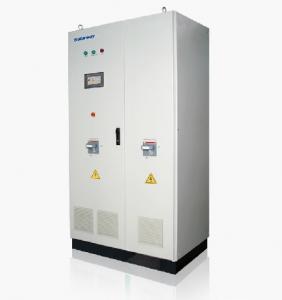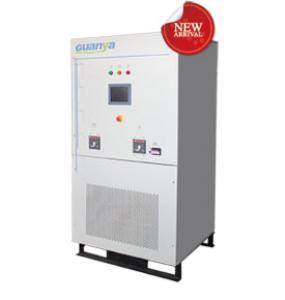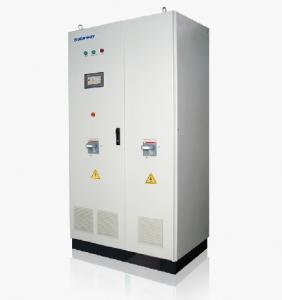PV On-Grid Inverter GSG-100KTV from China
OKorder Service Pledge
OKorder Financial Service
You Might Also Like
Description:
CNBMSOLAR is a world-leading and Vertical integrated manufacturer of high-performance with Silicon,
Wafer, Cells, Modules, which convert sunlight into electricity for residential, commercial, and utility-scale
power generation.
The capacity of CNBMSOLAR is reach to 1GW, and make sure each year our shipment capacity is more
Than 700-800MWs, at the same time, we have set up the largest solar power station with our partner
in Ukraine.
CNBM is a Quality + Service oriented company with“Excellence at Each Step” approach, composed of
the finest components from TUV and IEC-certified partners around the world, CNBM modules consistently
undergo a variety of trials at the company’s Test & Development Centre, ensuring peak performance
capabilities. The company is committed to develop and provide the world with clean and renewable energy
to ease the energy shortages as well as human kind’s impact on the environment.
Data:
Isolation mode | Transformer inside | Max. Input voltage(VDC) | 1000 |
Max. DC. Input power(KW) | 125 | Max. PV parallel module number | —— |
Max. Input current(A) | 250 | MPPT range(VDC) | 440~850 |
Recommend PV module power(VDC) | 720 | Rated Grid frequency(Hz) | 50 |
Rated AC output power(KW) | 110 | Euro efficiency | 96.50% |
Rated Grid voltage and allowed range(VAC) | 400/310~450 | THD | <3% |
Max efficiency | 97.20% | MPPT Precision | 99% |
Display | Touch screen | Electromagnetic compatibility | IEC61000-6-1/-2/-3/-4 |
Power factor | ≥0.99 | Grid detection | DIN VDE 0126-1-1-2010 |
Overload operating | Automatically adjust the running peak | Grid disruption | IEC61000-3-2/-3 |
Communication interface | RS485 | Internal consumption at night(W) | <50 |
DC voltage ripple | Vpp < 10% | Protection class | IP20(indoor) |
Anti-islanding protection | Vac;Fac | Ground fault monitoring protection | Yes |
Grid monitoring protection | Yes | DC reverse-polarity protection | Yes |
AC short-circuit capacity protection | Yes | DC switch protection | Yes |
Noisy(dB) | <30 | Cooling concept | Forced air cooling |
Operating temperature range(℃) | -20~55(>50℃drop) | Operating humid range | 0~95%(non-condensing) |
Dimensions(dxwxh mm) | 800×1000×1940 | Weight(Kg) | 1022 |
Altitude(m) | 6000(>3000m start to drop) |

FAQ:Could you pls introduce more about CNBM?
CNBM Group is short for China National Building Materials Group Corporation, which is established in 1984 with approval from the State Council
CNBM Group is the largest comprehensive building materials industry group in China
The Group has a total asset of over RMB 360 billion, more than 180,000 employees and 17 subsidiaries
- Q:How do you calculate the total power capacity for a solar inverter?
- To calculate the total power capacity for a solar inverter, you need to consider the maximum power output of the solar panels. This value is typically given as the DC power rating in watts. The inverter capacity should be equal to or slightly higher than the total DC power rating of the connected solar panels. This ensures optimal performance and avoids any power loss. Additionally, other factors such as the inverter's efficiency, temperature derating, and future expansion plans should also be taken into account when determining the total power capacity for a solar inverter.
- Q:What is the role of a remote monitoring system in a solar inverter?
- The role of a remote monitoring system in a solar inverter is to provide real-time data and analysis of the solar inverter's performance and energy generation. It allows for remote access and control, enabling the monitoring and management of the solar system from a central location. This includes monitoring the system's output, identifying and diagnosing any issues or faults, optimizing energy production, and ensuring overall system efficiency and reliability.
- Q:What is the role of reactive power injection in a solar inverter?
- The role of reactive power injection in a solar inverter is to improve power factor and stabilize the voltage in the electrical grid. By injecting reactive power, the inverter helps balance out the reactive power demand from other loads in the grid, reducing the strain on the system and ensuring efficient power transfer. This helps maintain grid stability and prevents voltage fluctuations, ultimately enhancing the overall performance and reliability of the solar power system.
- Q:What is the role of a solar inverter in fault ride-through capability?
- The role of a solar inverter in fault ride-through capability is to ensure that the solar power system remains connected to the grid during grid faults or disturbances. The inverter is responsible for detecting the fault and adjusting its operating parameters to ride through the fault without disconnecting from the grid. This capability helps maintain a stable and reliable power supply, as the solar inverter can continue to inject power into the grid even during temporary faults, reducing the impact on the overall system stability.
- Q:Can a solar inverter be used with dual-axis solar trackers?
- Yes, a solar inverter can be used with dual-axis solar trackers. A solar inverter is responsible for converting the direct current (DC) generated by the solar panels into alternating current (AC) that can be used to power electrical devices or be fed into the grid. The dual-axis solar trackers enable the solar panels to follow the sun's movement in both horizontal and vertical directions, maximizing their exposure to sunlight throughout the day. The solar inverter can still perform its function of converting DC to AC regardless of the type of solar tracking system used.
- Q:How does a solar inverter handle anti-islanding protection?
- A solar inverter handles anti-islanding protection by continuously monitoring the grid's voltage and frequency. If the grid's voltage or frequency deviates from the predetermined range, indicating a potential islanding condition, the inverter quickly disconnects from the grid to prevent energy flow. This ensures the safety of utility workers and prevents damage to the electrical grid.
- Q:How does the total harmonic distortion affect the performance of a solar inverter?
- Total harmonic distortion (THD) refers to the distortion in the waveform of an electrical signal caused by the presence of harmonics. In the case of a solar inverter, high levels of THD can negatively impact its performance. Excessive THD can lead to voltage and current waveform distortions, which can result in various issues such as reduced power quality, increased losses, and decreased efficiency of the solar inverter. These distortions can also affect the overall performance and lifespan of connected electrical devices, potentially leading to their malfunction or premature failure. Therefore, it is crucial to ensure that a solar inverter maintains low levels of THD to optimize its performance and minimize any adverse effects on the connected electrical systems.
- Q:What is the role of an isolation transformer in a solar inverter?
- The role of an isolation transformer in a solar inverter is to provide electrical isolation between the solar panels and the grid. It helps protect the solar panels and the inverter from electrical disturbances, such as voltage spikes or surges, that may occur in the grid. Additionally, the isolation transformer helps mitigate ground fault currents and provides a safety barrier between the grid and the solar system.
- Q:Are all solar inverters compatible with all solar panels?
- No, not all solar inverters are compatible with all solar panels. The compatibility between inverters and panels depends on various factors such as voltage, power rating, and technology used. It is important to ensure that the inverter you choose is specifically designed to work with the type and specifications of the solar panels you have.
- Q:Can a solar inverter be used with solar-powered water purification systems?
- Yes, a solar inverter can be used with solar-powered water purification systems. A solar inverter is responsible for converting the direct current (DC) produced by solar panels into alternating current (AC) that can be used to power electrical devices. In the case of solar-powered water purification systems, the solar panels generate electricity through sunlight, which is then converted by the solar inverter to power the purification system, ensuring clean and safe drinking water.
1. Manufacturer Overview |
|
|---|---|
| Location | |
| Year Established | |
| Annual Output Value | |
| Main Markets | |
| Company Certifications | |
2. Manufacturer Certificates |
|
|---|---|
| a) Certification Name | |
| Range | |
| Reference | |
| Validity Period | |
3. Manufacturer Capability |
|
|---|---|
| a)Trade Capacity | |
| Nearest Port | |
| Export Percentage | |
| No.of Employees in Trade Department | |
| Language Spoken: | |
| b)Factory Information | |
| Factory Size: | |
| No. of Production Lines | |
| Contract Manufacturing | |
| Product Price Range | |
Send your message to us
PV On-Grid Inverter GSG-100KTV from China
OKorder Service Pledge
OKorder Financial Service
Similar products
New products
Hot products
Hot Searches
Related keywords






























